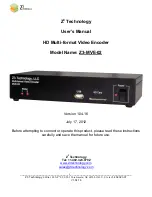
5 - 3
posed of microphone amplifier, compressor, scrambler,
limiter, splatter fi lter, MSK modulator, etc. at the microphone
amplifi er section.
The AF signals (MIC) from the microphone (MC1) are
applied to the amplifier (IC23, pins 6, 7). The amplified
signals are applied to the microphone amplifier section of
he base band IC (IC14, pins 3, 4). The amplified signals
are passed through or bypass the compressor, scrambler
sections of IC14, and are then passed through the high-
pass, limiter amplifi er, splatter fi lter sections of IC14.
The filtered AF signals are applied to the FM/PM switch
(IC13, pin 6), and pass through the low-pass fi lter (IC6, pin
2). The fi ltered signals are applied to the D/A converter (IC12,
pin 4). The output signals from the D/A converter (IC12, pin 3)
are applied to the modulation circuit (D12).
5-2-2 MODULATION CIRCUIT (MAIN UNIT)
The modulation circuit modulates the VCO oscillating signal
(RF signal) using the microphone audio signals.
The AF signals from the D/A converter (IC12, pin 3) change
the reactance of varactor diode (D12) to modulate the
oscillated signal at the TX VCO circuit (Q16, D10). The
modulated VCO signal is amplified at the buffer amplifiers
(Q15, Q29) and is then applied to the drive amplifi er circuit
via the T/R switch (D16).
The CTCSS/DTCS signals (“CENC0”, “CENC1”, ”CENC2”
from the CPU (IC22, pins 13, 15, 16) pass through the
lowpass fi lter (IC6, pins 12, 14), and are then applied to the
D/A converter via the “TONC” line (IC12, pin 12). The output
signal from the D/A converter (IC12, pin 11) are mixed with
“MOD” signal after pass through the low-pass fi lter (IC6).
The mixed siganls are applied to the D/A converter (IC12,
pin 3, 4), and are then applied to the D12 in the VCO circuit.
5-2-3 DRIVE/POWER AMPLIFIER CIRCUITS
(PA UNIT)
The drive/power amplifi er circuits amplify the VCO oscillating
signal to an output power level.
The signal from the VCO circuit passes through the T/R
switch (MAIN unit; D16), and is amplifi ed at the YGR (Q703,
Q704), drive (Q702), power (Q701) amplifi ers to obtain 4 W
of RF power (at 7.2 V DC).
The amplified signal is passed through the low-pass filter
(L704, C711, C712, C713, C755), power detector (D702,
D703), antenna switching circuit (D701) and another
lowpass fi lters (PA unit; L709, C744, C745), (ANT unit; L801,
L802, C802, C803, C804, C805), and is then applied to the
antenna connector (CHASSIS unit; J1).
The bias current of the drive (Q702) and power (Q701)
amplifi ers are controlled by the APC circuit.
5-2-4 APC CIRCUIT (PA AND MAIN UNITS)
The APC circuit protects the drive and power amplifi ers from
excessive current drive, and selects output power of HIGH
or LOW.
The power detector circuit (PA unit; D702, D703) detects the
transmit power output level and converts it into DC voltage.
The output voltage is at a minimum level when the antenna
impedance is matched with 50
Ω
and is increased when it is
mismatched.
The detected voltage is applied to the differential amplifi er
Power
amp.
APC
amp.
Driver
amp.
+
–
YGR
amp.
VCC
to ANT unit
PA unit
T2
TMUT
D29
RF signal
from PLL circuit
T5V
APC control circuit
D703
D702
YGR
amp.
ANT
SW
LPF
LPF
Q702
Q704
IC16
Q703
Q701
D701
• APC CIRCUIT
















































